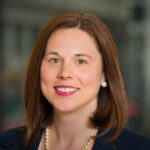In Looking at What’s Ahead for Education, readers can examine future possibilities raised by KnowledgeWorks’ recent explorations of the future of learning. This short publication provides a digest of these possibilities in five key areas that shape how education operates today and will determine what unfolds for education systems and learners in the future:
Focusing only on how learning happens today limits the scope of our imaginations and risks keeping the next generation of learners stuck in education systems that already struggle to keep pace with people’s needs. Considering a range of possibilities can help us pave the way for future education systems that are equitable and learner-centered.
Education constituents need to take a long view to make sure that the future of learning meets today’s hopes of helping students of all races and ethnicities, incomes and identities pursue the kinds of learning experiences that enable them to uncover their passions and thrive in an evolving world.
Inside Looking at What’s Ahead for Education, readers will:
Helping education constituents navigate today’s shifting landscape with resilience and success

Many people, especially – and tragically – many of our young learners, also lack a vision of the future for themselves.

Futures thinking can help us reimagine how education can best serve future generations.
A future of learning where students of all races and ethnicities, incomes and identities pursue the kinds of learning experiences that enable them to uncover their passions and thrive in an evolving world.
Subscribe to receive email updates including expert insights, success stories and resources.